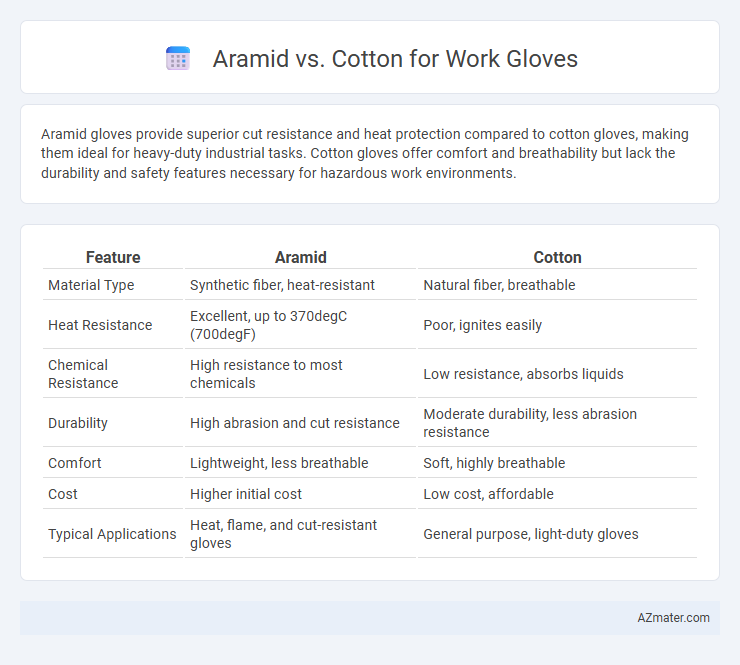Aramid gloves provide superior cut resistance and heat protection compared to cotton gloves, making them ideal for heavy-duty industrial tasks. Cotton gloves offer comfort and breathability but lack the durability and safety features necessary for hazardous work environments.
Table of Comparison
| Feature | Aramid | Cotton |
|---|---|---|
| Material Type | Synthetic fiber, heat-resistant | Natural fiber, breathable |
| Heat Resistance | Excellent, up to 370degC (700degF) | Poor, ignites easily |
| Chemical Resistance | High resistance to most chemicals | Low resistance, absorbs liquids |
| Durability | High abrasion and cut resistance | Moderate durability, less abrasion resistance |
| Comfort | Lightweight, less breathable | Soft, highly breathable |
| Cost | Higher initial cost | Low cost, affordable |
| Typical Applications | Heat, flame, and cut-resistant gloves | General purpose, light-duty gloves |
Introduction to Work Glove Materials
Aramid fibers in work gloves provide exceptional cut resistance and high heat tolerance, making them ideal for heavy-duty industrial tasks. Cotton gloves offer breathability and comfort but lack the durability and protective qualities found in aramid materials. Selecting work glove materials depends on the required balance between protection, flexibility, and comfort for specific job conditions.
What is Aramid?
Aramid fibers are synthetic fibers known for their exceptional strength, heat resistance, and durability, making them ideal for protective work gloves. Unlike cotton, aramid provides superior cut, abrasion, and heat protection, essential in industrial and hazardous environments. Aramid gloves maintain flexibility while offering long-lasting defense against mechanical and thermal risks.
What is Cotton?
Cotton is a natural fiber harvested from the seed hairs of the cotton plant, widely used in work gloves for its breathability and comfort. It offers good moisture absorption and softness but lacks the high heat and cut resistance found in synthetic fibers like aramid. While cotton gloves are suitable for light-duty tasks, they do not provide the durability or protective properties required in heavy industrial environments.
Key Differences Between Aramid and Cotton
Aramid fibers offer superior heat resistance, cut protection, and durability compared to cotton, making them ideal for heavy-duty work gloves in hazardous environments. Cotton gloves excel in breathability, comfort, and affordability but lack the high-performance safety features of aramid. The key differences lie in aramid's synthetic, flame-retardant properties versus cotton's natural, biodegradable composition.
Protection and Durability Comparison
Aramid fibers offer superior protection against cuts, abrasions, and heat compared to cotton, making them ideal for heavy-duty industrial gloves. Cotton provides comfort and breathability but lacks the enhanced durability and resistance to harsh environments found in aramid gloves. Workers exposed to sharp objects, high temperatures, or chemicals benefit significantly from aramid's strength and longevity in protective work gloves.
Comfort and Flexibility Analysis
Aramid work gloves provide superior heat resistance and durability but tend to be less breathable and flexible compared to cotton gloves. Cotton gloves offer excellent comfort and flexibility, allowing for better dexterity during detailed tasks, but they lack the high-strength protection against cuts and burns that aramid fibers provide. Choosing between aramid and cotton depends on balancing the need for protective performance with the desired comfort and ease of movement.
Heat and Chemical Resistance
Aramid gloves provide superior heat resistance withstanding temperatures up to 500degF, making them ideal for high-temperature industrial tasks. Their inherent flame-retardant properties also offer enhanced chemical resistance against oils, solvents, and some acids, surpassing the protective capabilities of traditional cotton gloves. Cotton gloves, while breathable and comfortable, lack significant heat and chemical resistance, making them less suitable for hazardous environments requiring robust safety measures.
Cost and Availability
Aramid gloves typically cost significantly more than cotton gloves due to their enhanced durability and heat resistance, making them a premium choice for heavy-duty work environments. Cotton gloves are widely available, affordable, and suitable for general-purpose tasks, but they lack the specialized protective properties of aramid fibers. Availability of aramid gloves may be limited to specialized suppliers, while cotton gloves can be found in most hardware and safety stores.
Best Applications for Aramid vs Cotton Gloves
Aramid gloves provide superior heat resistance, cut protection, and durability, making them ideal for welding, metal fabrication, and electrical work where high heat and sharp objects are common hazards. Cotton gloves excel in comfort, breathability, and light-duty tasks such as assembly, inspection, and general maintenance where protection against minor abrasions and dirt is needed. Choosing aramid gloves enhances safety in high-risk environments, while cotton gloves offer cost-effective protection for less demanding applications.
Choosing the Right Work Glove Material
Aramid gloves offer superior cut, heat, and abrasion resistance, making them ideal for heavy-duty industrial tasks where safety is critical. Cotton gloves provide breathability and comfort, suitable for light-duty work that requires dexterity and minimal protection. Selecting the right work glove material depends on the specific hazards of the job, with aramid preferred for high-risk environments and cotton for everyday general labor.

Infographic: Aramid vs Cotton for Work Glove
 azmater.com
azmater.com